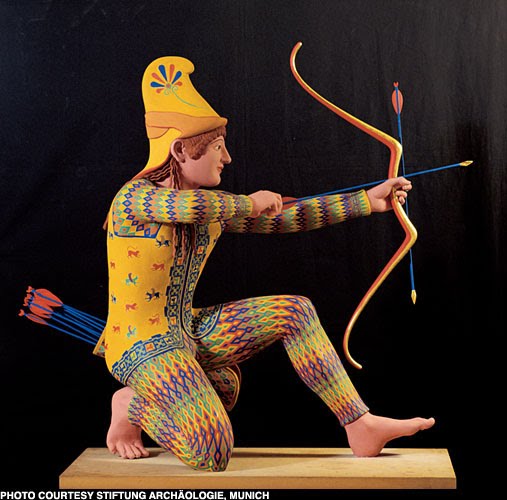While admiring the reconstruction efforts of Vinzenz Brinkmann, I believe that there are some nuances of painting on stone that are overlooked. In painting with encaustic glazes on stone (marble or alabaster), subtleties of opacity and sheen are possible which are overlooked in painting flat areas of color on plaster casts. Stone also has a luminosity, lacking in plaster, which can add a further depth of light and brilliance.
With the goal of showcasing the possibilities of encaustic painting on stone, I am undertaking a series of experiments. The first experiment is a modest one, involving small applications of encaustic paint on an alabaster carving. The goal of this experiment was to demonstrate the variations in opacity possible with encaustic, simply by diluting the pigment with more medium (wax and damar resin). (Only one color, with varying amounts of medium, was used in the experiment.) We have literary and visual (from vase-paintings) evidence of the application of encaustic paint to stone sculptures; I have updated the equipment a little by using an electric griddle rather than a metal vessel heated by charcoal. I also used a blow dryer to heat the paint on the surface of the stone; this makes the paint much more malleable, and I presume that the ancient Greeks were able to heat the work surface too, almost as a matter of necessity. A secondary goal of the first experiment was to demostrate the variations in surface sheen possible with encaustic; it is, after all, pigment suspended in wax, so it can be easily polished to a high gloss.
Adventures in re-creating the painted stone sculpture of the ancient Greeks.
Saturday, January 22, 2011
Subscribe to:
Posts (Atom)
Reference works
- Aletti, E. La tecnica della pittura greco e romano e l'encausto. Rome, 1951.
- Bluemel, C. Greek Sculptors at Work. Phaidon Press, 1969.
- Brinkmann, V. "The Polychromy of Ancient Greek Sculpture," in The Color of Life, ed. R. Panzanelli. Getty Publications, 2008,
- Brinkmann, V. Bunte Götter. Hamburg, 2007.
- Bruno, V.J. Form and Color in Greek Painting. London, 1977.
- Coulson, W.D.E. "The Reliability of Pliny's Chapters on Greek and Roman Sculpture." CW 69 (1976) 361-372.
- Dvorakowska, A. "Notes on the Terminology for Stones Used in Ancient Greece." Archeologia 28 (Wroclaw, 1977), 1-18.
- Etienne, H.J. The Chisel in Greek Sculpture. Leiden, 1968.
- Isager, J. Pliny on Art and Society: The Elder Pliny's Chapters on the History of Art. Oxford, 1991.
- Keuls, E. Plato and Greek Painting. Leiden, 1978.
- Ling, R. Making Classical Art: Process and Practice. Stroud UK, 2000.
- Mattusch, C. Classical Bronzes: The Art and Craft of Greek and Roman Statuary. Ithaca, 1996.
- Palagia, O. (ed.) Greek Sculpture: Function, Materials, and Techniques in the Archaic and Classical Periods. Cambridge, 2006.
- Richter, G.M. The Sculpture and Sculptors of the Greeks. Yale, 1930 (rev. 1950).
- Stewart, A. Greek Sculpture: an Exploration. New Haven, 1990.








